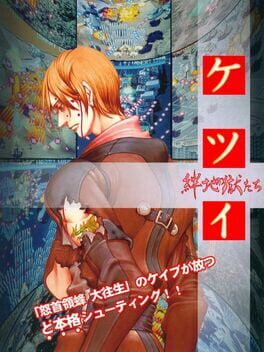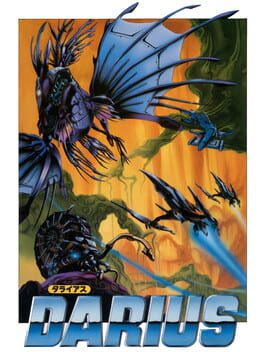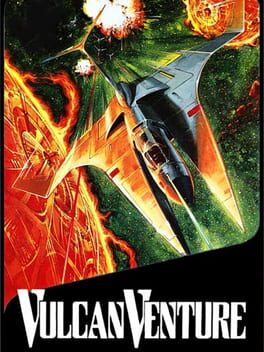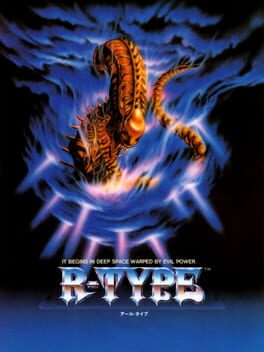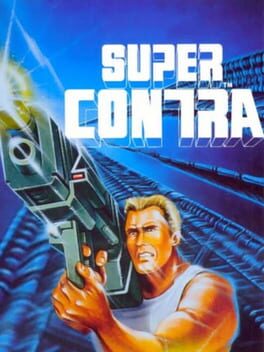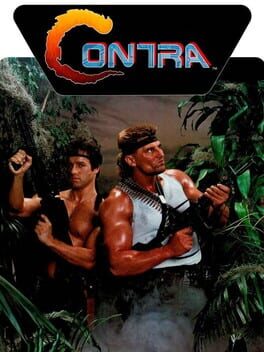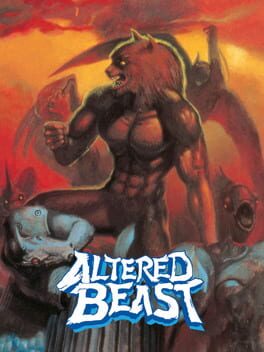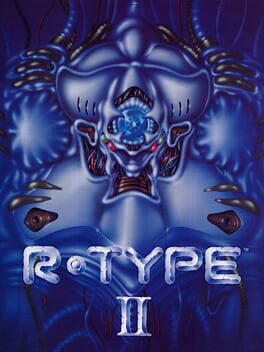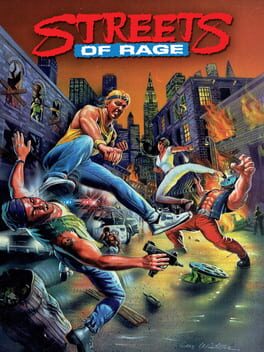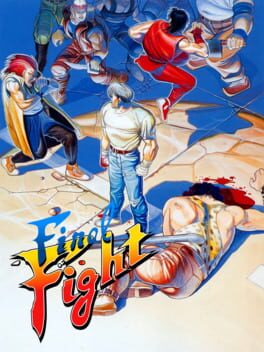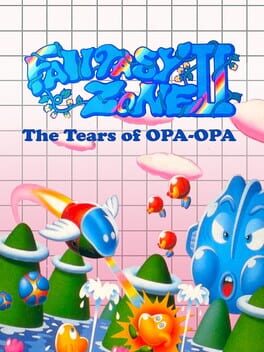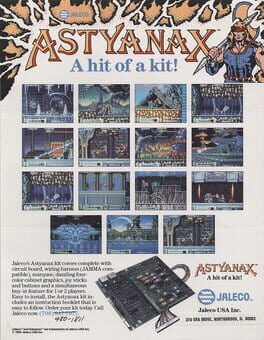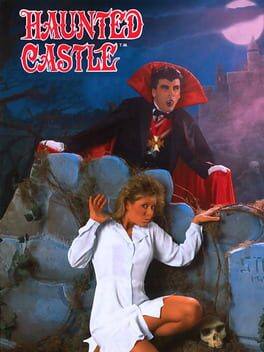ogremode
1987
The biggest impression Darius makes is it's presentation—super wide, projected from three CRTs side by side in the original cabinet. The levels look good, even though it's repetitive, the enemies and your ship look cool—but the boss enemies are the coolest, massive robotic fish that I have to imagine would take up most of a crt screen themselves.
The sense of choice and progression—both in your ship upgrades and in selecting each level—is decidedly utilitarian, but just enticing enough to make me want to replay, if only so I can see what bosses are behind door number two.
The sense of choice and progression—both in your ship upgrades and in selecting each level—is decidedly utilitarian, but just enticing enough to make me want to replay, if only so I can see what bosses are behind door number two.
1985
2006
I'm not sick of God Hand yet so for my third play through I decided to do a Kick Me Sign run—a challenge run in which you can never activate your tension meter, and you can never use your special roulette abilities. It's called a "kick me sign" run because in one of the early stages you get a kick me sign slapped on your back, and it drops off when you use those special abilities—I was surprised to learn that the sign is persistent throughout levels if you don't use your abilities. In fact you are rewarded with unlockable music tracks after completing it, though the game never explicitly mentions this run as far as I know, which is an interesting bit of design in itself. You're never technically locked away from using the special attacks either, so there's a level of self control to it. You can even activate the roulette ability to slow down time and make your character face an enemy, and then back out of the menu without selecting a special ability. I learned the hard way to be extra careful about this—if you accidentally hit the special attack and then let yourself get killed so you can start the level over, you'll actually have to go back to whatever your latest save was to get the sign back on your back.
My experience for the KMS run was surprisingly close to my prior play throughs. It's simple enough to live without "Unleashed Mode," which turns Gene invincible and lets you wail away at an enemy while your Tension Meter ticks down; in lieu of that, you're just forced to put more time and damage into enemies, and to be more careful and consistent about dodging. In other words, you're forced to play better. I felt the most pain without that ability fighting the enemies that were really good at dodging you—Tiger Joe, Devil Hand—since the Unleashed Mode gives you a bit of a breather and a level of essentially guaranteed damage. I also missed this mode when fighting the demons, since they tend to run away from you and it can be very annoying to chase them down.
The inability to use roulette moves are a different story, and really highlighted the gaps in Gene's toolbox. For one thing, there's no gap closing technique, no projectile, no easy crowd control move—without these in your back pocket, it can make certain encounters pretty annoying and hard to deal with at the higher difficulty levels. I eventually learned to rely on juggling enemies and separating them to keep things under control. I still don't have a great solution to when the game sends a whip wielder plus a couple of "leader" characters at you (the tall enemies that have some kind of gimmick—axe wielders, knife throwers, etc.). The whip wielder tends to hide behind these leader types, so your best bet is to do some hit and run attacks, but since they're cloistered together it's just as likely Gene will tackle the wrong enemy, and that's a tedious, fraught way to play already. I wish there was a larger variety of crowd control techniques too—there's the round house kick and the quicker, weaker round kick move, but your best move is to juggle enemies and launch them, which takes a lot of patience and skill to pull off when you're being attacked by multiple enemies.
I had a lot of fun with this challenge run but would be lying if I didn't say I found myself frustrated with certain limitations, but this is the first time, after two complete playthroughs, that I have felt that way about God Hand. I wouldn't recommend this challenge run necessarily unless you're like me and are trying to squeeze as much juice out of the game as possible. The in-game reward doesn't feel worth it, and the game feels designed to be played with the special abilities. But I might not completely feel that way once I finish the game on hard mode...
I'm still not sick of God Hand after finishing the run. After my third playthrough, I just wish I was better at God Hand. This time I managed to stay between second and third difficulty for most of the game, with dips into the fourth difficulty mode, but I felt really challenged in third difficulty already...
My experience for the KMS run was surprisingly close to my prior play throughs. It's simple enough to live without "Unleashed Mode," which turns Gene invincible and lets you wail away at an enemy while your Tension Meter ticks down; in lieu of that, you're just forced to put more time and damage into enemies, and to be more careful and consistent about dodging. In other words, you're forced to play better. I felt the most pain without that ability fighting the enemies that were really good at dodging you—Tiger Joe, Devil Hand—since the Unleashed Mode gives you a bit of a breather and a level of essentially guaranteed damage. I also missed this mode when fighting the demons, since they tend to run away from you and it can be very annoying to chase them down.
The inability to use roulette moves are a different story, and really highlighted the gaps in Gene's toolbox. For one thing, there's no gap closing technique, no projectile, no easy crowd control move—without these in your back pocket, it can make certain encounters pretty annoying and hard to deal with at the higher difficulty levels. I eventually learned to rely on juggling enemies and separating them to keep things under control. I still don't have a great solution to when the game sends a whip wielder plus a couple of "leader" characters at you (the tall enemies that have some kind of gimmick—axe wielders, knife throwers, etc.). The whip wielder tends to hide behind these leader types, so your best bet is to do some hit and run attacks, but since they're cloistered together it's just as likely Gene will tackle the wrong enemy, and that's a tedious, fraught way to play already. I wish there was a larger variety of crowd control techniques too—there's the round house kick and the quicker, weaker round kick move, but your best move is to juggle enemies and launch them, which takes a lot of patience and skill to pull off when you're being attacked by multiple enemies.
I had a lot of fun with this challenge run but would be lying if I didn't say I found myself frustrated with certain limitations, but this is the first time, after two complete playthroughs, that I have felt that way about God Hand. I wouldn't recommend this challenge run necessarily unless you're like me and are trying to squeeze as much juice out of the game as possible. The in-game reward doesn't feel worth it, and the game feels designed to be played with the special abilities. But I might not completely feel that way once I finish the game on hard mode...
I'm still not sick of God Hand after finishing the run. After my third playthrough, I just wish I was better at God Hand. This time I managed to stay between second and third difficulty for most of the game, with dips into the fourth difficulty mode, but I felt really challenged in third difficulty already...
1988
Gradius II/Vulcan Venture is an incremental upgrade to Gradius and Salamander/Life Force. The team took some of the ideas from Salamander for this game, like the fire dragon enemies.
I played through the Japanese arcade version on Konami Arcade Classics Anniversary Collection which was pretty managable until the last few levels. The last level is a true gauntlet. Besides flying through a cramped spaceship (that honestly reminded me a lot of the final level of Scramble), there's a section where you have to dive between the legs of a giant walking insect robot as it steps forward, then back, across the screen, and it was incredibly difficult. After you make it through all this, the game ends with a nastily rendered reward not-boss that looked really cool.
Gradius II notably has a pretty good boss rush level, but it also disappointingly drops the vertical sections, and I liked that variety and the sleek transitions from the prior two games.
I played through the Japanese arcade version on Konami Arcade Classics Anniversary Collection which was pretty managable until the last few levels. The last level is a true gauntlet. Besides flying through a cramped spaceship (that honestly reminded me a lot of the final level of Scramble), there's a section where you have to dive between the legs of a giant walking insect robot as it steps forward, then back, across the screen, and it was incredibly difficult. After you make it through all this, the game ends with a nastily rendered reward not-boss that looked really cool.
Gradius II notably has a pretty good boss rush level, but it also disappointingly drops the vertical sections, and I liked that variety and the sleek transitions from the prior two games.
1987
Irem's debut shooter, R-Type, is a really special game. It has incredible art direction, really going for the overtly sexual aspects of the Giger look that most games are too cowardly to use; one of the bosses you'll be fighting is a bunch of worm penises emerging from vaginas.
It also has the "Force," an invincible option, that connects to your ship in front of or behind you; it acts as a shield, absorbing enemy fire. You can fire the Force so it floats horizontally and fires; often bosses will have a hard to reach weak area that you can fling your Force into to continue doing damage even while it's locked off from your main ship. It's a really fun addition.
However I had an insanely hard time getting through it. The game is beyond arcade difficult. I played through it with infinite credits and I'm glad I got to see it all, even though dying constantly stopped me from playing with too many of the upgrades, but it can not be overstated how difficult it is.
It also has the "Force," an invincible option, that connects to your ship in front of or behind you; it acts as a shield, absorbing enemy fire. You can fire the Force so it floats horizontally and fires; often bosses will have a hard to reach weak area that you can fling your Force into to continue doing damage even while it's locked off from your main ship. It's a really fun addition.
However I had an insanely hard time getting through it. The game is beyond arcade difficult. I played through it with infinite credits and I'm glad I got to see it all, even though dying constantly stopped me from playing with too many of the upgrades, but it can not be overstated how difficult it is.
1988
1987
1988
1989
More R-Type. I found this one a smidge easier than the first game. Excellent art and art direction, and brings a few more ideas to the genre, like the waterfalls that push your ship down, or the final boss where you have to fire through gates that flip and block you off. Cool bosses in general, and has some really nice looking mecha enemies.
1991
Streets of Rage begins as a pretty straight Renegade/Final Fight riff, though its even more boiled down than that game. Maybe popping open the manual would explain things a bit, but I played the whole game without it being completely clear to me how to grapple. Altogether it feels pretty rudimentary, but it gets by on its excellent soundtrack and the sheer look of it.
1989
Final Fight isn't the first "beat them up" game, but it's the moment the genre became tolerable, and it can even reach heights of fun. I played through the game using all the characters, but my favorite was the huge Mike Haggar. The characters all play slightly differently, and have different special moves. I don't like that the special moves burn health to use them—the idea is that they should become tactical, but the moveset is somewhat limited, so I found myself using the special moves pretty often. I'm also not good at this game whatsoever, but the game doesn't make me want to get good at it.
Enemy types that appear in God Hand
- Cars
- Knife throwers
- Women that jump around like ninjas
- Homophobia
- Fat guys
- Andre the Giant looking guys
Enemy types that appear in God Hand
- Cars
- Knife throwers
- Women that jump around like ninjas
- Homophobia
- Fat guys
- Andre the Giant looking guys
1987
The sequel to Fantasy Zone is more Fantasy Zone. A lot more Fantasy Zone. Maybe too much more Fantasy Zone.
The core game is exactly the same—search horizontal scrolling levels for special enemies, which you have to destroy before fighting a boss—but this game shakes things up by adding warp icons that take you to new screens within levels. Every new screen multiplies the length by that much, and it can be tedious to navigate the warp system. The icons are always blue, and there's usually two on a screen—there's no way to tell where you're going without memorizing what each icon leads to, so you'll often jump from cleared screen to cleared screen looking for the screen that still has enemies to destroy on it. Even though the warps persistently take you to the same place, it feels like the Lost Woods or something because of how easy it is to get lost—the only distinguishing feature between the two jumps on each stage are if they're on the left or on the right. When you land in another stage from these jumps, you're somewhere away from the warp icons, so you can't really tell which one will take you back to the one you came from. This system makes the game really tedious—not only is there a lot more enemies to kill before you get to the next boss, but the warp system is confounding. I wish there was something in place to stop you from getting lost—either have the warp always take you to a level with enemies to kill, or use different colored warp icons so I can distinguish them easier. Once you kill all the enemies, the boss room unlocks—these have red warp icons, but you still have to navigate to the stage with the boss icon. There's no indication that you've killed all the required enemies either, so you might try the boss icon, find it doesn't work, then have to search the level for the remaining bad guys to kill.
The bosses themselves are as fun as the first one. They're usually pretty interesting shooting game bosses where you have to hit a weak spot or a bunch of weak spots to take them down. The exception is the final boss, which moves to the left and will crush you if you can't kill it fast enough, which you can't unless you're way better at this game than I am, or unless you're beefed up on upgrades before going into it. In general in this game it feels like buying upgrades is a lot more necessary than it was in the first game, as the required enemies are real bullet sponges for your regular attack but will melt away if you've got an expensive weapon. Money is never an issue, but its tedious to go back to the store constantly.
I have to say I like the sequel to the Fantasy Zone a bit less than I liked the original, but it's still bright and feels pretty fun, even if it gets a little tiresome. I played the Master System version, but the arcade version looks pretty different (and less tedious), so I might check that one out.
The core game is exactly the same—search horizontal scrolling levels for special enemies, which you have to destroy before fighting a boss—but this game shakes things up by adding warp icons that take you to new screens within levels. Every new screen multiplies the length by that much, and it can be tedious to navigate the warp system. The icons are always blue, and there's usually two on a screen—there's no way to tell where you're going without memorizing what each icon leads to, so you'll often jump from cleared screen to cleared screen looking for the screen that still has enemies to destroy on it. Even though the warps persistently take you to the same place, it feels like the Lost Woods or something because of how easy it is to get lost—the only distinguishing feature between the two jumps on each stage are if they're on the left or on the right. When you land in another stage from these jumps, you're somewhere away from the warp icons, so you can't really tell which one will take you back to the one you came from. This system makes the game really tedious—not only is there a lot more enemies to kill before you get to the next boss, but the warp system is confounding. I wish there was something in place to stop you from getting lost—either have the warp always take you to a level with enemies to kill, or use different colored warp icons so I can distinguish them easier. Once you kill all the enemies, the boss room unlocks—these have red warp icons, but you still have to navigate to the stage with the boss icon. There's no indication that you've killed all the required enemies either, so you might try the boss icon, find it doesn't work, then have to search the level for the remaining bad guys to kill.
The bosses themselves are as fun as the first one. They're usually pretty interesting shooting game bosses where you have to hit a weak spot or a bunch of weak spots to take them down. The exception is the final boss, which moves to the left and will crush you if you can't kill it fast enough, which you can't unless you're way better at this game than I am, or unless you're beefed up on upgrades before going into it. In general in this game it feels like buying upgrades is a lot more necessary than it was in the first game, as the required enemies are real bullet sponges for your regular attack but will melt away if you've got an expensive weapon. Money is never an issue, but its tedious to go back to the store constantly.
I have to say I like the sequel to the Fantasy Zone a bit less than I liked the original, but it's still bright and feels pretty fun, even if it gets a little tiresome. I played the Master System version, but the arcade version looks pretty different (and less tedious), so I might check that one out.
1990
I picked up Jaleco's The Astyanax after hearing it mentioned in comparison to Haunted Castle in Cane and Rinse's episode on that game. And rightfully so—in almost every way, The Astyanax is a much stronger execution of a Castlevania arcade idea. I miss using Vampire Hunter, but Roche's axe is satisfying to wield, and has a cool property to it where it will have some hitbox behind your character when Roche swings it back before slamming it forward, so you can end up being surrounded but still be taking out the enemies around you without too much fuss. A few times I was annoyed by the composition of the enemies on the screen—a combination of attack patterns that make it almost impossible to play without taking damage, or too many enemies who take a lot of hits to kill at once, but it wasn't nearly as much of a problem as it is in Haunted Castle. The enemy types lean more fantasy than gothic or Universal horror—mantis men, Harryhausen style cyclops, knights, flying demons with spears that reminded me of the bat wing demons from Anor Londo.
There's one elevator level where enemies drop from the sky, but most of the levels are simple left to right affairs, usually with a handful of platforming heights you can jump between. Each level is arcade short, and culminates in a boss battle. The bosses are pretty simple, though they're more of a fight than Haunted Castle's reward-bosses, and I love seeing the big dragons and wizard and so on. The second to last level even has a sorcerer that feels very Dracula esque as he teleports around and sends beams of attacks at you.
The big surprise is the last level after the sorcerer fight. Roche goes through a portal and is teleported to an H.R. Giger-esque dungeon. The enemy types here are mostly face hugger types that jump at your face, and the final boss is inexplicably a Xenomorph right out of Aliens. The Xenomorph's main attack is extending his arm at you, which really isn't Xenomorph-esque at all. Still, it's a shocking sequence, and I have to imagine absolutely no one would believe you about it back in the day.
There's one elevator level where enemies drop from the sky, but most of the levels are simple left to right affairs, usually with a handful of platforming heights you can jump between. Each level is arcade short, and culminates in a boss battle. The bosses are pretty simple, though they're more of a fight than Haunted Castle's reward-bosses, and I love seeing the big dragons and wizard and so on. The second to last level even has a sorcerer that feels very Dracula esque as he teleports around and sends beams of attacks at you.
The big surprise is the last level after the sorcerer fight. Roche goes through a portal and is teleported to an H.R. Giger-esque dungeon. The enemy types here are mostly face hugger types that jump at your face, and the final boss is inexplicably a Xenomorph right out of Aliens. The Xenomorph's main attack is extending his arm at you, which really isn't Xenomorph-esque at all. Still, it's a shocking sequence, and I have to imagine absolutely no one would believe you about it back in the day.
1987
I'm a sucker for the "classicvania" style and figured I'd give this one a try. It was really attractive to me—for one, the arcade sprites are huge and beautiful—admire Simon's Chun-li-esque thighs—and I was interested in seeing how the platforming acton translated into coin-op form. It turns out not very well.
I played the infamously difficult Haunted Castle on the Japanese rom, having heard it's easier than the American one. I was having an alright time until the third level, when it was taking four slaps of my level 1 vampire killer (I had died and lost my power up) to kill this game's flea variant; you simply don't have enough time to fire off four hits before the enemy hits you. Your other option is to rush the enemy and duck at exactly the right moment so he would fly over Simon, but it's 1) really hard to time and 2) useless when two of them are rushing at you, or there's a knight involved. I reset the game, ready to try to get there again with the level 2 vampire killer (which swaps the whip for a morning star flail) to see if it did more damage, and then dug into the settings. Sure enough, Konami Arcade Collection graciously supplies difficulty modifiers. I turned enemy enemy damage on low, and difficulty to easy. It was certainly easier, but still a pain in the ass.
The final level is a long bridge sequence to Dracula's castle. The bridge collapses behind you, while bats dive at you in front of you. When you stop to attack, the bridge collapsing doesn't pause, so as you defend yourself from bats while crossing the bridge you move ever closer to falling off. In fact, if you successfully kill every single bat you encounter, you are certain to be pushed off the falling bridge. However, these bats don't knock you back, so you can truck through them, but you'll take damage. You're forced to strategically kill bats and alternatively take damage while crossing the bridge, and figuring out exactly how many bats to kill to maximize leftover health for the Dracula fight was a weird experience. It's a fascinating bit of design where you literally cannot get through without taking damage. This learning process didn't feel great, but I found it was successfully thematic. You're not getting away clean if you want to kill Dracula. (I found after that you can also just memorize when the bats swoop down then time a jump to kill it as it does, but I'm too stupid for that kind of solution.)
Dracula himself was a total chump, and went down in just a few hits. In general, the bosses of this game are just rewards for making your way through the difficult levels, which I don't mind. I liked seeing Frankenstein and the Gorgon in arcade style, even if you only see them for a few moments.
I can't really recommend this game—The Astyanax is a much better Castlevania arcade game—but I'm glad I checked it out. It's an interesting curiosity and worth seeing if you're a fan of Castlevania.
I played the infamously difficult Haunted Castle on the Japanese rom, having heard it's easier than the American one. I was having an alright time until the third level, when it was taking four slaps of my level 1 vampire killer (I had died and lost my power up) to kill this game's flea variant; you simply don't have enough time to fire off four hits before the enemy hits you. Your other option is to rush the enemy and duck at exactly the right moment so he would fly over Simon, but it's 1) really hard to time and 2) useless when two of them are rushing at you, or there's a knight involved. I reset the game, ready to try to get there again with the level 2 vampire killer (which swaps the whip for a morning star flail) to see if it did more damage, and then dug into the settings. Sure enough, Konami Arcade Collection graciously supplies difficulty modifiers. I turned enemy enemy damage on low, and difficulty to easy. It was certainly easier, but still a pain in the ass.
The final level is a long bridge sequence to Dracula's castle. The bridge collapses behind you, while bats dive at you in front of you. When you stop to attack, the bridge collapsing doesn't pause, so as you defend yourself from bats while crossing the bridge you move ever closer to falling off. In fact, if you successfully kill every single bat you encounter, you are certain to be pushed off the falling bridge. However, these bats don't knock you back, so you can truck through them, but you'll take damage. You're forced to strategically kill bats and alternatively take damage while crossing the bridge, and figuring out exactly how many bats to kill to maximize leftover health for the Dracula fight was a weird experience. It's a fascinating bit of design where you literally cannot get through without taking damage. This learning process didn't feel great, but I found it was successfully thematic. You're not getting away clean if you want to kill Dracula. (I found after that you can also just memorize when the bats swoop down then time a jump to kill it as it does, but I'm too stupid for that kind of solution.)
Dracula himself was a total chump, and went down in just a few hits. In general, the bosses of this game are just rewards for making your way through the difficult levels, which I don't mind. I liked seeing Frankenstein and the Gorgon in arcade style, even if you only see them for a few moments.
I can't really recommend this game—The Astyanax is a much better Castlevania arcade game—but I'm glad I checked it out. It's an interesting curiosity and worth seeing if you're a fan of Castlevania.
